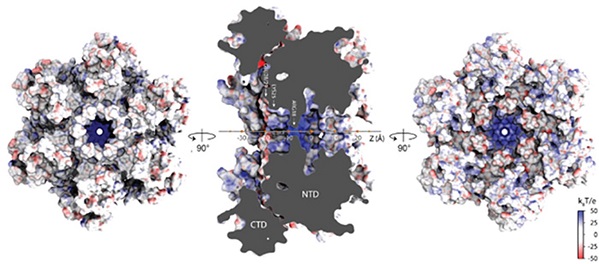
The HIV-1 virus has evolved a way to import nucleotides for DNA synthesis needed for its life cycle, according to Juan R. Perilla at the University of Delaware. Credit: Xu, et al.
By Jorge Salazar, Science Writer, Texas Advanced Computing Center
Viruses lurk in the grey area between the living and the nonliving, according to scientists. Like living things, they replicate but they don’t do it on their own. The HIV-1 virus, like all viruses, needs to hijack a host cell through infection in order to make copies of itself.
Supercomputer simulations supported by the National Science Foundation-funded Extreme Science and Engineering Discovery Environment (XSEDE) have helped uncover the mechanism for how the HIV-1 virus imports into its core the nucleotides it needs to fuel DNA synthesis, a key step in its replication. It’s the first example found where a virus performs an activity such as recruiting small molecules from a cellular environment into its core to conduct a process beneficial for its life cycle.
The computational biophysics research, published December 2020 in PLOS Biology, challenges the prevailing view of the viral capsid, long considered to be just a static envelope housing the genetic material of the HIV-1 virus.
“To my knowledge, it’s the first piece of work that comprehensively shows an active role of the capsids in regulating a very specific lifecycle of the virus, not only computationally, but also in vitro assays and ultimately in the cells,” said study co-author Juan R. Perilla, a biophysical chemist at the University of Delaware.
The research team collaborated with several research groups, including experimental groups at the University of Pittsburgh School of Medicine and the Harvard Medical School. These groups validated the predictions from molecular dynamics (MD) simulations by using atomic force microscopy and transmission electron microscopy.
“For our part, we used MD simulations,” said lead author Chaoyi Xu, a graduate student in the Perilla Lab. “We studied how the HIV capsid allows permeability to small molecules, including nucleotides, IP6, and others.” IP6 is a metabolite that helps stabilize the HIV-1 capsid.
It’s rare for a computational paper to be in a biology journal, explained Perilla. “The reason this is possible is that we are discovering new biology,” he said. The biology relates to the stability of the virus to import small molecules that it needs for certain metabolic pathways. “In the context of HIV, it’s the fuel for the reverse transcription that occurs inside of the capsid.”
The enzyme reverse transcriptase generates complimentary DNA, one-half of DNA that pairs up in the cell to complete the full invading viral DNA. The viral DNA enters the host cell nucleus, integrates into the host cell DNA, and uses the cell’s machinery to crank out new viral DNA.
“In these series of experiments and computational predictions, what we have shown is that the capsid itself plays an active role in the infective cycle,” Perilla said. “It regulates the reverse transcription — how the viral DNA synthesizes inside of the capsid.” He explained that these processes are the result of millions of years of co-evolution between the virus and the target cell.
“Without supercomputers, the computational part of the study would have been impossible,” added Xu. The challenge was that the biological problem of nucleotide translocation would require a longer timescale than would be possible to sample using atomistic molecular dynamics simulations.
Instead, the researchers used a technique called umbrella sampling coupled with Hamiltonian replica exchange. “The advantage of using this technique is that we can separate the whole translocation process into small windows,” Xu said. In each small window, they ran individual small MD simulations in parallel on supercomputers.

Stampede2 at TACC (left) and Bridges at PSC (right) are allocated through the NSF-funded Extreme Science and Engineering Discovery Environment.
“By using the resources provided from XSEDE, we were able to run and not only test the translocation processes, but also the effects of small molecules binding on the translocation process by comparing the free energy differences calculated from our results.”
XSEDE awarded Perilla and his lab access to two supercomputing systems used in the HIV capsid research: Stampede2 at the Texas Advanced Computing Center (TACC); and Bridges at the Pittsburgh Supercomputing Center (PSC).
“TACC and PSC have been extremely generous to us and very supportive,” Perilla said.
“When I transferred from Stampede1 to Stampede2, the hardware was a big improvement. At the time, we were fascinated with the Intel Xeon Skylake nodes. They were fantastic,” Perilla said.
“On Bridges, we took advantage of the high memory nodes. They have these massive memory machines with 3 and 12 terabytes of inline memory. They’re really good for analysis. Bridges provides a very unique service to the community,” he continued.
On related work, the Perilla Lab has also employed through XSEDE the PSC Bridges-AI system, and they have been part of the early user science program for PSC’s Bridges-2 platform.
“We’ve enjoyed this early science period on Bridges-2,” Perilla said. “The experts at PSC want us to hammer the machine as much as we can, and we’re happy to do that. We have a lot of work that needs to be done.”
Perilla related that the XSEDE Campus Champion program has also helped in his mission for training the next generation of computational scientists. The program enlists 600+ faculty and staff at more than 300 universities to help students, faculty, and postdocs take full advantage of XSEDE’s cyberinfrastructure resources.
“We received an immense amount of help from our XSEDE Campus Champion, Anita Schwartz.” Perilla said. “She helped us with everything that is related to XSEDE. We also took advantage of the training programs. The younger members of our lab took advantage of the training opportunities offered by XSEDE.”
Xu recalled finding them helpful for learning how to get started using XSEDE supercomputers, and also for learning the Simple Linux Utility for Resource Management (SLURM), which is the project job management used for supercomputers.
“By taking these courses, I familiarized myself with using these supercomputers, and also to use them to solve our research questions,” Xu said.
What’s more, the University of Delaware launched in December 2020 the Darwin supercomputer, a new XSEDE-allocated resource.
“The students in the group have had the opportunity to train on these fantastic machines provided by XSEDE, they’re now at the point that they’re expanding that knowledge to other researchers on campus and explaining the details of how to make the best use of the resource,” Perilla said. “And now that we have an XSEDE resource here on campus, it’s helping us create a local community that is as passionate about high performance computing as we are,”
Perilla sees this latest work on the HIV-1 capsid as providing a new target for therapeutic development. Because there is no cure for HIV and the virus keeps getting drug resistance, there’s a constant need to optimize anti-retroviral drugs.
Said Perilla: “We’re very enthusiastic about supercomputers and what they can do, the scientific questions they allow us to pose. We want to reproduce biology. That’s the ultimate goal of what we do and what supercomputers enable us to do.”
The study, “Permeability of the HIV-1 capsid to metabolites modulates viral DNA synthesis,” was published December 17, 2020 in the journal PLOS Biology. The authors are Chaoyi Xu, Brent Runge, Roman Zadorozhnyi, Tatyana Polenova, and Juan R. Perilla of the University of Delaware; Douglas K. Fischer, Jinwoo Ahn, and Zandrea Ambrose of the University of Pittsburgh School of Medicine; Wen Li and Alan N. Engelman of Harvard Medical School; Sanela Rankovic and Itay Rousso of the Ben-Gurion University of Negev; Robert A. Dick of Cornell University; Christopher Aiken of the Vanderbilt University Medical Center. This work was supported by the US National Institutes of Health grants P50AI1504817, P20GM104316, R01AI147890, R01AI070042, and R01AI107013.



